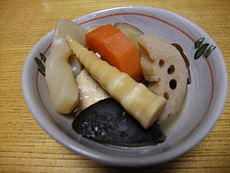Nimono
Appearance
This articleneeds additional citations forverification.(January 2018) |
 Nishime,a nimono of various vegetables (includingbamboo shoot,lotus rootandshiitake) prepared in southernAomori Prefecture | |
| Course | Side dish |
|---|---|
| Place of origin | Japan |
| Region or state | Japanese-speaking areas |
| Main ingredients | Vegetable or seafood,dashi,sake,soy sauce,mirin |
| Similar dishes | Jorim |

Nimono(Nấu vật)is a simmered dish inJapanese cuisine.A nimono generally consists of a base ingredient simmered inshirustock and seasoned withsake,soy sauce,and a small amount of sweetening. The nimono is simmered in the shiru over a period of time until the liquid is absorbed into the base ingredient or evaporated. The base ingredient for a nimono is typically a vegetable, fish, seafood, ortofu,or some combination of these. Theshirustock for a nimono is generallydashi.Other than sake and soy sauce, the stock can be further flavored withmirin,sugar,salt,vinegar,miso,or othercondiments.
Types
[edit]
- Misoni(Miso nấu),alsomisodaki(Miso xuy き):fish, but sometimes vegetables, simmered in a mixture of miso and dashi[1]
- Nikujaga(Thịt じゃが):beef and potato stew, flavoured with sweet soy
- Nizakana(Nấu cá):fish poached in a broth of sweetened dashi, sometimes with miso, also referred to asnitsuke(Nấu phó け).The dish first appears in cookbooks in the early 18th century[2]
- Kakuni(Giác nấu):chunks of pork belly stewed in soy, mirin and sake with large pieces of daikon and whole boiled eggs. The Okinawan variation, using awamori, soy sauce and miso, is known asrafuti.
- Sōki(ソーキ):Okinawan dish of pork stewed with bone
- Nabemono(Nồi vật):one pot
- Nishime(Nấu nhiễm め):simmered vegetables (i.e.carrots,taros,lotus root,konnyaku,etc.), simmered-down in soy sauce and water until the liquid is almost gone, almost to dryness.
See also
[edit]References
[edit]- ^"Miso nấu"[Misoni].Nihon Kokugo Daijiten(in Japanese). Tokyo: Shogakukan. 2012.OCLC56431036.Archived fromthe originalon 2007-08-25.Retrieved2012-06-27.
- ^"Nấu cá"[Nizakana].Nihon Kokugo Daijiten(in Japanese). Tokyo: Shogakukan. 2012.OCLC56431036.Archived fromthe originalon 2007-08-25.Retrieved2012-06-27.
Bibliography
[edit]- Hosking, Richard (2000).At the Japanese Table.Images of Asia. New York: Oxford University Press.ISBN978-0-195-90980-7.LCCN00058458.OCLC44579064.
- Ashkenazi, Michael; Jacob, Jeanne (2000).The Essence Of Japanese Cuisine: an Essay On Food And Culture.Richmond, Surrey: Curzon.ISBN978-0-700-71085-0.OCLC44937736.
